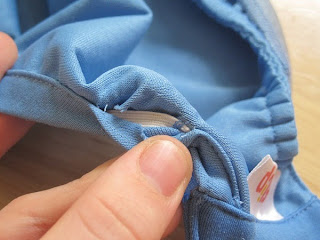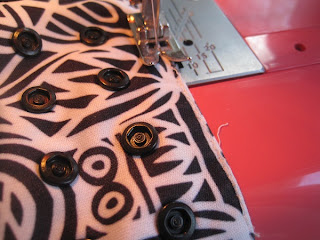I personally, just don't like velcro on nappies. I find that it wears badly, and I can't stand it sticking to other things in the washing machine and making them bobbly. I find snaps (poppers) make for a much more secure fit.
And also, I'm slightly mad. So I decided to change my entire stash of Bumgenius v.4 pockets over to snaps. Some were already snaps, but I had around 12 to change. After all that changing, I thought a little tutorial would be handy for others who are looking to change their nappies over too, so here we are!
You will need....
- Scissors
- Seam ripper
- Paper or thin card
- Ruler
- Pen
- Pokey thing (I used a darning needle, some pliers come with a tool just for making holes)
- Snap press or pliers (I used a hand held one, around £12)
- Snaps! (I'm using KAM type plastic snaps, size 20). You need 24 caps, 20 'female' sockets and 4 'male' bits.
- Patience
1. Look at your nappy. Pretty depressing. Let's get started on removing the old worn velcro.
2. We'll start with the laundry tabs at the back. Simply lift the back flap of the pocket, and gently unpick the stitches using your trusty seam ripper.
3. To remove the wing velcro, I find it easiest to cut across (make sure not to cut the actual nappy) with some nice sharp scissors, and then unpick with the seam ripper.
4. Next is the waistband velcro. This needs to be done VERY VERY gently, as you don't want to make any holes here. You can either attack it from the front, or fold the pocket inside out and go from inside. I use a bit of both. Take your time.
5. Now we're going to make a template for the placement of the snaps. I'm using a Bumgenius v.4 pocket for my template. You could use another nappy that you like the fit of, or I have provided the measurements below. Bumgenius nappies have 2 rows of ten female snaps along the waistband and two vertically placed male snaps on each wing. Some people prefer using just one row of snaps, it's up to you!
6. Here is my template. It is 30cm long, and 6cm wide (there is no need to taper the edges like I have done, I just like being fancy is all!). You need two horizontal lines going all the way across, one 2.5cm from the top, and another 5cm from the top. Fold your strip of paper exactly in half. From this middle line measure 1.25cm to the right and mark with a small dot. From this dot, mark out four more dots with 2.5cm in between. Do the same on both lines, for both sides, making sure the four middle dots measure 1.25cm from the middle line. You should end up with ten dots on each line, 2.5cm apart. I made mine into little crosses so I could see them easier. Hope that makes sense...if it doesn't, please let me know!
7. Using your poking tool (knitting/darning needle in my case) poke a hole through each cross.
8. Right. Using the center rise snap as a guide, place your template on top of the nappy. Make sure the top edge of the template is flush against the top of the nappy and the middle line is in line with the center rise snap. Make sense so far? Using your pen, do a little dot through the pre-made hole. In this picture I'm using a biro, but I actually found a Sharpie or felt tip pen best.
9. You'll be left with a series of dots along the nappy. Time for that handy poking tool again. Putting your hand with the needle INSIDE the actual pocket of the nappy, carefully locate the dot from the inside and push out. It is important to make sure you are only going through the waterproof fabric and not the stay-dry lining. You can do all twenty dots at once, or do each one after you've placed each snap. Up to you.
10. It's Snappy Happy time! These are your snaps. Far left are CAPS. Middle is FEMALE. Far right is MALE. This is how I will be referring to them from now on. You need a cap for each male and female part. So for this nappy, you will need twenty four caps, twenty females and four males.
11. Grab a cap. Putting your hand inside the pocket again, locate the hole you just made with your needle, and push the cap through.
12. Place a female on top of this cap, press it down slightly. You may want to trim the cap at this point, because if the prong is too long, it will not set in properly and it won't snap. Simply take your nice sharp scissors, lay them flat across the female, and snip off the very tip of the prong.
13. Get your handy snap pliers, make sure the cap is sitting nicely in the bottom hole, line up and press. Remember the flat side of the cap is inside the pocket, so there is the layer of stay dry fabric between the pliers and the cap (I do advise practising on something else first if you've got spare snaps).
14. TA DA!!! You did now. Now do the other 19.
15. Time for the wing snaps. I did these completely by eye, so have no measurements for you. It is pretty easy though. The hard bit is getting the needle through the fabric! Two caps, and two males on each side.
And that is it. Here's a load I did. You can do it in loads of different ways - match the snap colour to the nappy, use different colours, I even mixed up the caps and females for my Eiffel Tower (black and white Chelsea Perry print) to create a black and white spotty look. The red has exact matching colour snaps, the blue and pink have alternate rows of different colours, and the cream has loads of different coloured pastel snaps.
There will be teeny holes where you removed the velcro. I found that after a couple of washes these have mostly disappeared.
I got my pliers and KAM snaps from The Little Fabric Bazaar on Facebook. She has the vast majority of colours to match your nappies, and is the only place I could find that sells snaps in packs of 20. Very fast and fantastic service!






















.JPG)





































